
Even if in Greece there are still not many vegetarians, to the point that in some areas may not even know what a vegetarian is exactly, eating out for those who follow a vegetarian or vegan diet is often much easier than in other European countries, including Italy…
[sam id=”7″]
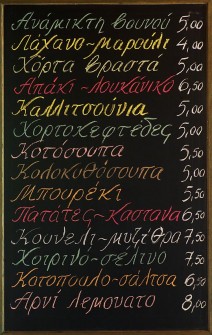 The thing is quite simple to explain and is linked to the Greek orthodox religion. The religious fasts are in fact very common and respected by most of the population, especially in rural areas. The classical periods are before Easter (40 days) before Christmas (40 days) and before August 15th, the feast of the Virgin Mary, (15 days). during these periods Greeks do not eat meat and animal products (dairy products, etc..) on Fridays not even oil. Seafood and shellfish, including shrimp and octopus are allowed. This practice has created a whole series of recipes so-called “fasting” (“nistìsimes” in Greek).
The thing is quite simple to explain and is linked to the Greek orthodox religion. The religious fasts are in fact very common and respected by most of the population, especially in rural areas. The classical periods are before Easter (40 days) before Christmas (40 days) and before August 15th, the feast of the Virgin Mary, (15 days). during these periods Greeks do not eat meat and animal products (dairy products, etc..) on Fridays not even oil. Seafood and shellfish, including shrimp and octopus are allowed. This practice has created a whole series of recipes so-called “fasting” (“nistìsimes” in Greek).
For a start, a key piece of information, that is the biggest problem that I usually encounter in Italy: in Greece lard is not used for cooking, only olive oil and butter in some cases (especially in sweets). So bread and related products are always suitable for vegetarians and vegans (for traditional greek bread also milk is never used).
Also it is quite rare, although not impossible, that meat stocks are used for cooking vegetables… If in doubt ask, let’s say that the traditional cuisine, the one you find in traditional tavernas, does not use stock cubes of any kind.
Following you will find a list of the most common dishes of traditional Greek tavern that are suitable for vegetarians and vegans. If you choose to eat in a more sophisticated restaurants, pay attention to variations that may have been made by different chefs.
The majority of dishes for vegetarians and vegans are usually found among the starters.
Tiganità (fried): various types of fried vegetables zucchini, eggplant, potatoes, peppers. Vegan.
 Keftèdes (Croquettes), Croquettes of vegetables such as zucchini, eggplant, spinach, chickpeas and tomato are often on the menu in addition to classic meatballs. They rarely contain meat if not explicitly stated, instead almost always they contain cheese and / or eggs.
Keftèdes (Croquettes), Croquettes of vegetables such as zucchini, eggplant, spinach, chickpeas and tomato are often on the menu in addition to classic meatballs. They rarely contain meat if not explicitly stated, instead almost always they contain cheese and / or eggs.
 Pitte e Burekakia: there is no exact translation, they can be pies with various fillings or triangular pastry (phyllo) triangles stuffed. The name usually indicates clearly what is contained in the filling and butter is usually used in the dough, unless they are designated as ‘nistisimes‘ which means that they do not contain butter and/or cheese.
Pitte e Burekakia: there is no exact translation, they can be pies with various fillings or triangular pastry (phyllo) triangles stuffed. The name usually indicates clearly what is contained in the filling and butter is usually used in the dough, unless they are designated as ‘nistisimes‘ which means that they do not contain butter and/or cheese.
The sweet version, with a cream made with milk, eggs and semolina, is called ‘bougatsa‘. Attention, in northern Greece the name ‘bougatsa’ indicate both sweet and salty pies.
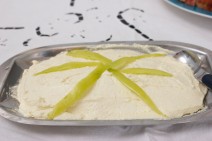

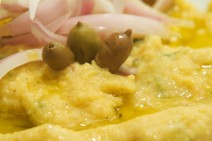
Salàtes (Salads): In addition to the classic Greek salads, choriatiki etc. There is a whole category of creamy salads that for the most part are vegetarian, some vegan too.
The only non-vegetarian I think it’s Taramosalata based on fish eggs. Tirosalàta, Tirokafteri and Chtipitì are made of cheese (tiri), the last two are spicy.
Melitzanosalata, eggplant puree in the traditional version is vegan, but some add a tablespoon of yogurt, better ask.
Tzatziki, made of yogurt, cucumber and garlic
Skordalia, made of garlic and potatoes, vegan
Hummus, it is not a Greek specialty but you can find it more and more often, chickpeas, tahini and lemon. vegan
Fava, mashed fava beans, vegan
 Chòrta, (vlita, radikia ecc.), boiled herbs of various kinds, Vegan
Chòrta, (vlita, radikia ecc.), boiled herbs of various kinds, Vegan
Piperies Florinis: marinated red peppers, vegan
Volví, bitter pickled onions, vegan
Dakos, the Cretan salad, Vegetarian
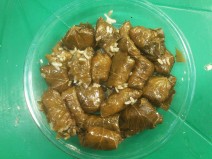 Dolmadakia Yialantzi: rolls of grape leaves stuffed with rice, rarely there may be meat in the filling, ask for safety. They are sometimes served with a sauce made of yogurt, vegans better ask. Not to be confused with the Lachanodolmades, rolls in cabbage leaves, which almost always have a meat filling; The first are dark green and the latter whitish
Dolmadakia Yialantzi: rolls of grape leaves stuffed with rice, rarely there may be meat in the filling, ask for safety. They are sometimes served with a sauce made of yogurt, vegans better ask. Not to be confused with the Lachanodolmades, rolls in cabbage leaves, which almost always have a meat filling; The first are dark green and the latter whitish
Kolokithoanthoùs, roulades made from the flower of zucchini stuffed with rice, usually without meat, but better ask
Melitzanes me Feta (Papoutsàki), eggplant with cheese and tomato sauce, vegetarian
Bouyiourdì, typical of northern Greece, like a Greek salad but hot, vegetarian
Saganaki (smal pan dishes), the traditional one is made with seasoned cheese, can also be of feta cheese, vegetables or seafood.
Staka, is found only in Crete, is the fattest part of the milk that is processed as a cream
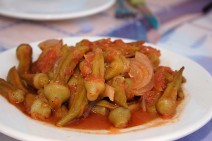 Laderà (dishes made with oil): this category is mostly vegan, if it is not explicitly said that they contain meat (sometimes snails) dishes are made only with vegetables, spices and oil. Typical dishes include green beans, Gigantes (large baked beans), baked potatoes, peas, artichokes alla polita, Bamies (Okra, virtually unknown in Europe, many like it).
Laderà (dishes made with oil): this category is mostly vegan, if it is not explicitly said that they contain meat (sometimes snails) dishes are made only with vegetables, spices and oil. Typical dishes include green beans, Gigantes (large baked beans), baked potatoes, peas, artichokes alla polita, Bamies (Okra, virtually unknown in Europe, many like it).
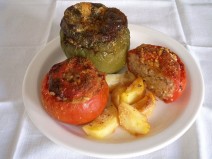 Gemistà (stuffed vegetables) usually tomatoes and peppers, but sometimes zucchini, eggplant and potatoes, stuffed with rice, in rare cases there may be meat in the filling, ask for safety.
Gemistà (stuffed vegetables) usually tomatoes and peppers, but sometimes zucchini, eggplant and potatoes, stuffed with rice, in rare cases there may be meat in the filling, ask for safety.
Eggplant Imam, usually vegan
Revìthia, revithada , chickpea soup, vegan
Fakes, lentil soup, vegan
Fasolada, bean soup, vegan
Spanakòrizo, rice and spinach, vegan
Prassòrizo, rice with leeks, Vegan
Chestnuts Stew, is rarely found and only in Crete, vegan and you must taste it!
Spaghetti Napolitana, attention I have seen more than once to use the meat sauce for pasta, calling it Napolitana, avoid!
I’m sure I forgot several dishes, but I hope however that this list might come in handy to someone to be able to order at a restaurant with a little more peace of mind 🙂
[sam id=”7″]
